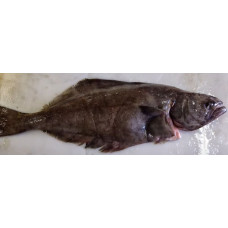Latin name
Reinhardtius hippoglossoides
Other names
Greenland turbot
Identification
The body is elongated and covered with fine cycloid scales. The eyes are located on the right side of the head. The upper eye is located at the top of the head. The mouth is large, with symmetrically placed sharp teeth. There are two rows of teeth on the upper jaw and one row on the lower jaw. The gill rays are short and thick; there are 2-4 gill rays on the upper part of the first gill ray and 10-12 on the lower part. The pectoral fins on each side of the body are about the same length. The long dorsal fin with 83-108 soft rays begins behind the eye and extends to the caudal peduncle. The anal fin has 62-84 soft rays and no spine. The caudal fin is truncated. Lateral line with 100 -119 scales, almost straight, branching at the head. The upper branch reaches the upper eye, the lower branch passes under the lower eye.
Fish colouring
The ocular side is dark, greyish brown to brown. The blind side is paler with a bluish tinge.
Distribution
The species is found in the northern parts of the Atlantic and Pacific Oceans and in the seas of the Arctic Ocean.
Habitat
Marine benthopelagic fish. They live at depths between 10 and 2000 metres.
Size
Maximum length 130 cm, usually up to 80-100 cm; mass up to 44.5 kg.
Behavior
Most of the halibut that live in northwest Greenland stay in their area and do not migrate to the open sea. However, fish from Davis Strait and the south-west Greenland fjords can migrate as far as Iceland.
Food and feeding habits
Predators. Halibut larvae feed on microscopic zooplankton (water fleas, shrimp and fish larvae) found in the upper layers of the water. Adult halibut mainly stay on the bottom where they feed on fish, shrimp and squid, but sometimes swim up in the water column in search of prey such as cuttlefish and polar cod.
Reproduction
Female halibut become sexually mature at approximately 10 years of age (at 60 cm in length). Males become sexually mature at about 7 years of age (at 50 cm in length). Mature halibut release their eggs at depths of over 1,000 metres. Large females can lay as many as 280,000 eggs. Eggs are about 4mm in diameter and hatch after 50-60 days of development. Halibut larvae, measuring 10-12 mm, are found in the upper 50 metres of the water column from May to the end of August, where they drift with the current as they grow. For the first few weeks, the larvae live in an egg sac and then begin to feed on plankton. The larva resembles a fish with one eye on each side of the head, but as it grows and flattens, one eye gradually moves to the back.
Fishing
Valuable commercial fish.
| Classification | |
| Phylum | Chordata |
| Class | Actinopterygii |
| Squad | Pleuronectiformes |
| Family | Pleuronectidae |
| Genus | Reinhardtius |
| Species | R. hippoglossoides |
| Features | |
| Conservation status | Near Threatened |
| Habitat | Pelagic |
| Life span, years | No information |
| Maximum body weight, kg | 44,5 |
| Maximum length, cm | 130 |
| Sailing speed, m/s | No information |
| Threat to people | Edible |
| Way of eating | Predator |
Greenland halibut
Tags: greenland halibut

